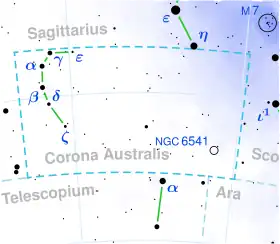 | |
| Observation data Epoch J2000.0 Equinox J2000.0 (ICRS) | |
|---|---|
| Constellation | Corona Australis |
| Right ascension | 18h 47m 44.61759s[1] |
| Declination | −40° 24′ 22.1955″[1] |
| Apparent magnitude (V) | 5.22±0.01[2] |
| Characteristics | |
| Spectral type | G5/6 III[3] |
| B−V color index | +0.78[4] |
| Astrometry | |
| Radial velocity (Rv) | −18.2±0.8[5] km/s |
| Proper motion (μ) | RA: +23.690 mas/yr[1] Dec.: −18.373 mas/yr[1] |
| Parallax (π) | 8.4545 ± 0.0993 mas[1] |
| Distance | 386 ± 5 ly (118 ± 1 pc) |
| Absolute magnitude (MV) | −0.22[6] |
| Details[7] | |
| Mass | 3.07±0.11 M☉ |
| Radius | 11.4±0.3 R☉ |
| Luminosity | 104±5 L☉ |
| Surface gravity (log g) | 3.15±0.08 cgs |
| Temperature | 5,448±27 K |
| Metallicity [Fe/H] | −0.14±0.03 dex |
| Rotational velocity (v sin i) | 7.7±1[8] km/s |
| Age | 361±66[9] Myr |
| Other designations | |
| Database references | |
| SIMBAD | data |
Mu Coronae Australis (Mu CrA), Latinized from μ Coronae Australis, is a solitary yellow-hued star[12] located in the southern constellation Corona Australis. It has an apparent magnitude of 5.22,[2] making it faintly visible to the naked eye. Gaia DR3 parallax measurements put it 386 light years away[1] and is currently approaching the Solar System with a heliocentric radial velocity of −18.2 km/s.[5] At its current distance, Mu CrA's brightness is diminished by 0.31 magnitudes due to interstellar dust.[13] It has an absolute magnitude of −0.22.[6]
Mu CrA has a stellar classification of G5/6 III,[3] indicating that it is an evolved G-type star with the characteristics of a G5 and G6 giant star. At an age of 365 million years,[9] the star has exhausted the supply of hydrogen at its core and has expanded to 11.4 times the radius of the Sun. At present it has 3.07 times the mass of the Sun and radiates 104 times the luminosity of the Sun from its enlarged photosphere at an effective temperature of 5,448 K. Mu CrA is slightly metal deficent and spins modestly with a projected rotational velocity of 7.7 km/s.[8]
References
- 1 2 3 4 5 6 Vallenari, A.; et al. (Gaia collaboration) (2023). "Gaia Data Release 3. Summary of the content and survey properties". Astronomy and Astrophysics. 674: A1. arXiv:2208.00211. Bibcode:2023A&A...674A...1G. doi:10.1051/0004-6361/202243940. S2CID 244398875. Gaia DR3 record for this source at VizieR.
- 1 2 Høg, E.; Fabricius, C.; Makarov, V. V.; Urban, S.; Corbin, T.; Wycoff, G.; Bastian, U.; Schwekendiek, P.; Wicenec, A. (March 2000). "The Tycho-2 catalogue of the 2.5 million brightest stars". Astronomy and Astrophysics. 355: L27–L30. Bibcode:2000A&A...355L..27H. ISSN 0004-6361.
- 1 2 Houk, Nancy (1978). Michigan catalogue of two-dimensional spectral types for the HD stars Volume II: Declinations −53° to −40°. Bibcode:1978mcts.book.....H.
- ↑ Johnson, H. L.; Mitchell, R. I.; Iriarte, B.; Wisniewski, W. Z. (1966). "UBVRIJKL Photometry of the Bright Stars". Communications of the Lunar and Planetary Laboratory. 4: 99–110. Bibcode:1966CoLPL...4...99J.
- 1 2 Gontcharov, G. A. (November 2006). "Pulkovo Compilation of Radial Velocities for 35 495 Hipparcos stars in a common system". Astronomy Letters. 32 (11): 759–771. arXiv:1606.08053. Bibcode:2006AstL...32..759G. doi:10.1134/S1063773706110065. eISSN 1562-6873. ISSN 1063-7737. S2CID 119231169.
- 1 2 Anderson, E.; Francis, Ch. (May 2012). "XHIP: An extended hipparcos compilation". Astronomy Letters. 38 (5): 331–346. arXiv:1108.4971. Bibcode:2012AstL...38..331A. doi:10.1134/S1063773712050015. eISSN 1562-6873. ISSN 1063-7737. S2CID 119257644.
- ↑ Ottoni, G.; Udry, S.; Ségransan, D.; Buldgen, G.; Lovis, C.; Eggenberger, P.; Pezzotti, C.; Adibekyan, V.; Marmier, M.; Mayor, M.; Santos, N. C.; Sousa, S. G.; Lagarde, N.; Charbonnel, C. (January 2022). "CORALIE radial-velocity search for companions around evolved stars (CASCADES): I. Sample definition and first results: Three new planets orbiting giant stars". Astronomy & Astrophysics. 657: A87. arXiv:2201.01528. Bibcode:2022A&A...657A..87O. doi:10.1051/0004-6361/202040078. eISSN 1432-0746. ISSN 0004-6361.
- 1 2 De Medeiros, J. R.; Alves, S.; Udry, S.; Andersen, J.; Nordström, B.; Mayor, M. (January 2014). "A catalog of rotational and radial velocities for evolved stars V: Southern stars". Astronomy & Astrophysics. 561: A126. arXiv:1312.3474. Bibcode:2014A&A...561A.126D. doi:10.1051/0004-6361/201220762. eISSN 1432-0746. ISSN 0004-6361. S2CID 54046583.
- 1 2 Feltzing, S.; Holmberg, J.; Hurley, J. R. (October 2001). "The solar neighbourhood age-metallicity relation - Does it exist?". Astronomy & Astrophysics. 377 (3): 911–924. arXiv:astro-ph/0108191. Bibcode:2001A&A...377..911F. doi:10.1051/0004-6361:20011119. eISSN 1432-0746. ISSN 0004-6361. S2CID 4811000.
- ↑ Gould, Benjamin Apthorp (1878). "Uranometria Argentina : brillantez y posicion de las estrellas fijas, hasta la septima magnitud, comprendidas dentro de cien grados del polo austral : con atlas". Resultados del Observatorio Nacional Argentino. 1. Bibcode:1879RNAO....1.....G.
- ↑ "mu. CrA". SIMBAD. Centre de données astronomiques de Strasbourg. Retrieved September 24, 2019.
- ↑ Eggleton, P. P.; Tokovinin, A. A. (11 September 2008). "A catalogue of multiplicity among bright stellar systems". Monthly Notices of the Royal Astronomical Society. 389 (2): 869–879. arXiv:0806.2878. Bibcode:2008MNRAS.389..869E. doi:10.1111/j.1365-2966.2008.13596.x. eISSN 1365-2966. ISSN 0035-8711. S2CID 14878976.
- ↑ Gontcharov, George A.; Mosenkov, Aleksandr V. (28 September 2017). "Verifying reddening and extinction for Gaia DR1 TGAS main sequence stars". Monthly Notices of the Royal Astronomical Society. 472 (4): 3805–3820. arXiv:1709.01160. Bibcode:2017MNRAS.472.3805G. doi:10.1093/mnras/stx2219. eISSN 1365-2966. ISSN 0035-8711.